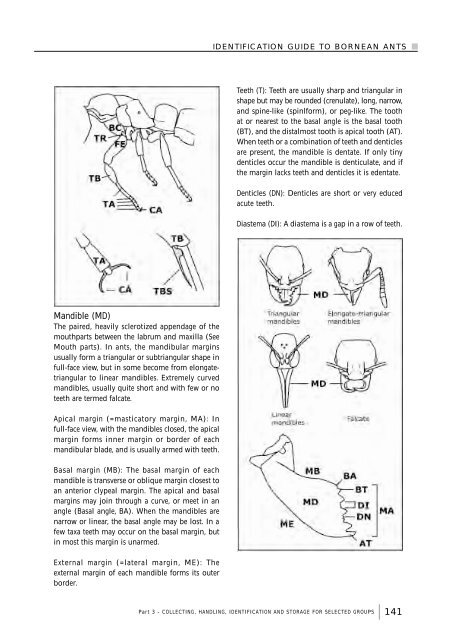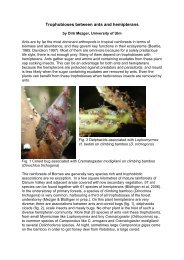Identification guide to the ant genera of Borneo - AntBase.net
Identification guide to the ant genera of Borneo - AntBase.net
Identification guide to the ant genera of Borneo - AntBase.net
Create successful ePaper yourself
Turn your PDF publications into a flip-book with our unique Google optimized e-Paper software.
IDENTIFICATION GUIDE TO BORNEAN ANTS<br />
Teeth (T): Teeth are usually sharp and triangular in<br />
shape but may be rounded (crenulate), long, narrow,<br />
and spine-like (spinlform), or peg-like. The <strong>to</strong>oth<br />
at or nearest <strong>to</strong> <strong>the</strong> basal angle is <strong>the</strong> basal <strong>to</strong>oth<br />
(BT), and <strong>the</strong> distalmost <strong>to</strong>oth is apical <strong>to</strong>oth (AT).<br />
When teeth or a combination <strong>of</strong> teeth and denticles<br />
are present, <strong>the</strong> mandible is dentate. If only tiny<br />
denticles occur <strong>the</strong> mandible is denticulate, and if<br />
<strong>the</strong> margin lacks teeth and denticles it is edentate.<br />
Denticles (DN): Denticles are short or very educed<br />
acute teeth.<br />
Diastema (DI): A diastema is a gap in a row <strong>of</strong> teeth.<br />
Mandible (MD)<br />
The paired, heavily sclerotized appendage <strong>of</strong> <strong>the</strong><br />
mouthparts between <strong>the</strong> labrum and maxilla (See<br />
Mouth parts). In <strong>ant</strong>s, <strong>the</strong> mandibular margins<br />
usually form a triangular or subtriangular shape in<br />
full-face view, but in some become from elongatetriangular<br />
<strong>to</strong> linear mandibles. Extremely curved<br />
mandibles, usually quite short and with few or no<br />
teeth are termed falcate.<br />
Apical margin (=mastica<strong>to</strong>ry margin, MA): In<br />
full-face view, with <strong>the</strong> mandibles closed, <strong>the</strong> apical<br />
margin forms inner margin or border <strong>of</strong> each<br />
mandibular blade, and is usually armed with teeth.<br />
Basal margin (MB): The basal margin <strong>of</strong> each<br />
mandible is transverse or oblique margin closest <strong>to</strong><br />
an <strong>ant</strong>erior clypeal margin. The apical and basal<br />
margins may join through a curve, or meet in an<br />
angle (Basal angle, BA). When <strong>the</strong> mandibles are<br />
narrow or linear, <strong>the</strong> basal angle may be lost. In a<br />
few taxa teeth may occur on <strong>the</strong> basal margin, but<br />
in most this margin is unarmed.<br />
External margin (=lateral margin, ME): The<br />
external margin <strong>of</strong> each mandible forms its outer<br />
border.<br />
Part 3 - COLLECTING, HANDLING, IDENTIFICATION AND STORAGE FOR SELECTED GROUPS<br />
141




